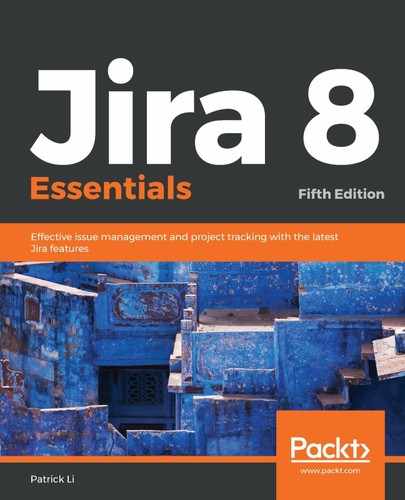Jira comes with a CSV importer, which lets you import data in the comma-separated value (CSV) format. This is a useful tool if you want to import data from a system that is not directly supported by Jira, since most systems are able to export their data in CSV.
Go through the following steps to import data through a CSV file:
- Select the Import External Project option from the Projects drop-down menu.
- Click on the CSV importer option. This will start the import wizard.
- First, you need to select the CSV file that contains the data you want to import by clicking on the Choose File button.
- After you have selected the source file, you can also expand the Advanced section to select the file encoding and delimiter used in the CSV file. There is also a Use an existing configuration option, which we will talk about this later in this section.
- Click on the Next button to proceed, as shown in the following screenshot:

- For the second step, you need to select the project you want to import our data into. You can also select the Create New option to create a new project on the fly.
- If your CSV file contains date-related data, ensure that you enter the format used in the Date format field.
- Click on the Next button to proceed, as shown in the following screenshot:

- For the third step, you need to map the CSV fields to the fields in Jira. Not all fields need to be mapped. If you do not want to import a particular field, simply leave the corresponding Jira field selection as Don't map this field.
- For fields that contain data that needs to be mapped manually, such as select list fields, you need to check the Map field value option. This will let you map the CSV field value to the Jira field value so they can be imported correctly. If you do not manually map these values, they will be copied over as is.
- Click on the Next button to proceed, as shown in the following screenshot:

- For the last step, you need to map the CSV field value to the Jira field value. This step is only required if you have checked the Map field value option for a field in step 10.
- Enter the Jira field value for each CSV field value.
- Once you are done with mapping field values, click on the Begin Import button to start the actual import process, as shown in the following screenshot. Depending on the size of your data, this may take some time to complete:

- Once the import process completes, you will get a confirmation message that tells you the number of issues that have been imported, as shown in the following screenshot. This number should match the number of records you have in the CSV file:

On the last confirmation screen, you can click on the download a detailed log link to download the full log file containing all the information for the import process. This is particularly useful if the import was not successful.
You can also click on the save the configuration link, which will generate a text file containing all the mappings you have done for this import. If you need to run a similar import in the future, you can even use this import file so that you will not need to manually remap everything again. To use this configuration file, check the Use an existing configuration file option in step 4.
As we can see, Jira's project importer makes importing data from other systems simple and straightforward. However, you must not underestimate its complexity. For any data migration, especially if you are moving off one platform and onto a new one, such as Jira, there are a number of factors you need to consider and prepare for. The following list summarizes some of the common tasks for most data migrations:
- Evaluate the size and impact. This includes the number of records you will be importing and also the number of users that will be impacted by this.
- Perform a full gap analysis between the old system and Jira; for example, consider how the fields will map from one to the other.
- Set up test environments for you to run test imports on to make sure that you have your mappings done correctly.
- Involve your end users as early as possible and have them review your test results.
- Prepare and communicate any outages and support procedures post-migration.
